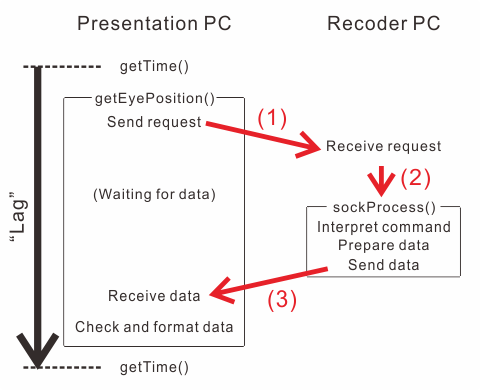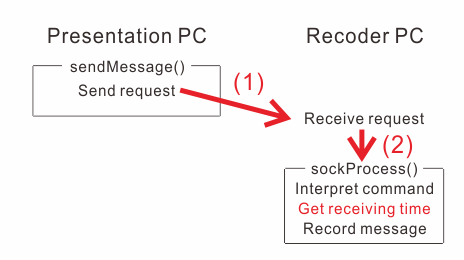Delay in communication between PCs¶
Delay in sending a message from the Presentation PC to the Recorder PC spoils synchronization between gaze positon data and messages.
Although It is difficult to estimate this delay precisely, Sample01 provides come clues for this problem.
In the sample01, time spent in getEyePosition() is recorded.
preGet = trialClock.getTime()
eyePos= tracker.getEyePosition()
postGet = trialClock.getTime()
if not eyePos[0] == None:
data.append((1000*preGet,1000*postGet,1000*(postGet-preGet),
targetPosition[0],targetPosition[1],eyePos[0],eyePos[1]))
In the local log file, time spent in getEyePosition() is recorded at the third column (labeled 'Lag').
Unit of this value is milliseconds.:
SentAt,ReceivedAt,Lag,TargetX,TargetY,EyeX,EyeY
0.0,0.5,0.5,0,0,-6.0,-31.0
14.3,14.9,0.6,0,0,-7.0,-27.0
18.7,19.0,0.3,0,0,-7.0,-27.0
33.9,34.2,0.3,0,0,-3.0,-30.0
50.6,50.9,0.3,0,0,0.0,-30.0
67.3,67.6,0.3,0,0,-6.0,-32.0
84.0,84.3,0.3,0,0,-2.0,-30.0
100.6,101.0,0.3,0,0,-2.0,-32.0
117.3,117.6,0.3,0,0,-7.0,-30.0
134.0,134.4,0.3,0,0,-4.0,-34.0
150.7,151.0,0.3,0,0,-9.0,-31.0
167.4,167.7,0.3,0,0,-11.0,-31.0
184.1,184.4,0.3,0,0,-10.0,-30.0
200.7,201.1,0.3,0,0,-6.0,-31.0
217.4,217.7,0.3,0,0,-6.0,-33.0
(snip)
For reference, the mean and standard deviation of the lag in this example output were 0.65ms and 0.79ms, respectively. The mode was 0.3ms, and the maximum value was 3.8ms. PCs used to generate this example output are shown in Table 1. In my experience, the mean and mode of the lag is shorter than 1.0ms when PCs with recent Intel mid-range CPU (e.g. Core i5, i7) and recent OS (e.g. Windows 7, ubuntu 12.04) are used.
Presentation PC |
|
Recorder PC |
|
Figure 1 shows the inside of GazeParser.TrackingTools.BaseController.getEyePosition().
The lag indicates time spent to do these tasks.
Probably time-consuming tasks are network transportation (1 and 3) and calling sockProcess() after receiving the request (2).

Figure 1¶
Figure 2 shows the inside of sendMessage().
Timestamp of the message is determined immediately after sockProcess() function recognized that the received request is 'sendMessage'.
Because task (3) is unnecessary in sendMessage(), delay in sendMessage() must be shorter than that in getEyePosition().

Figure 2¶
In conclusion, delay in sending message can be roughly estimated by running Sample01 several times. The delay must be shorter than 'Lag' in the local log file of Sample01.
